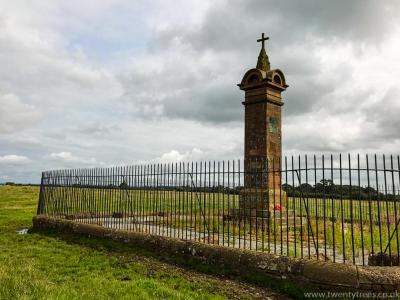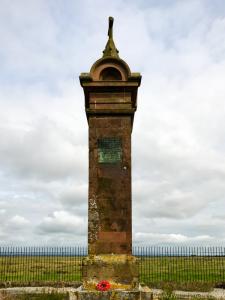Death of Edward I
Death of Edward I is in 1300-1309 Scottish Succession.
On 07 Jul 1307 King Edward "Longshanks" I of England (age 68) died at Burgh by Sands [Map] whilst on his way north to Scotland. His son King Edward II of England (age 23) succeeded II King England. Earl Chester merged with the Crown.
Edward (age 68) had gathered around him Thomas Plantagenet 2nd Earl of Leicester, 2nd Earl Lancaster, Earl of Salisbury and Lincoln (age 29), Guy Beauchamp 10th Earl Warwick (age 35), Aymer de Valence 2nd Earl Pembroke (age 32) and Robert Clifford 1st Baron Clifford (age 33) and charged them with looking after his son in particular ensuring Piers Gaveston 1st Earl Cornwall (age 23) didn't return from exile.



Britannia Volume 3. On the spot where Edward I died, the memory of which event was preferved by fome great stones rolled on it, is erected a handsome square pillar nine yards and an half high with this inscription in Roman capitals on the west side:
Memoriæ æternæ Edvardi I. regis Angliæ longè clarissimi , qui in belli apparatu contra Scotos occupatus hic in castris obiit 7 Julii A. 0 . 1307.
On the south, Nobilissimus princeps Henricus Howard dux Norfolciæ comes mareshall. Anglia , comes Arund &c ...... ab Edvardo I. rege Angliæ oriundus. P. 1685.
On the north, Johannes Aglionby I. C. F. C. i. e. juris consultus fieri curavit.
Monument to King Edward "Longshanks" I of England at the location [Map] at which he died. By Thomas or John Longstaff for the Duke of Norfolk and John Aglionby. Red sandstone ashlar. Tall square column on moulded plinth, moulded cornice, shaped cap surmounted by cross. Latin inscription on south side to memory of Edward I, who died in his camp at Burgh by Sands, 7 July 1307; east side inscription giving titles of Henry Howard, Duke of Norfolk and date 1685; west side inscription John Aglionby. Also had inscription, Tho Longstaff, Fecit 1685 (Ms 7/3f191, St Edmund Hall, Oxford). Bronze plaque records restoration by the Earl of Lonsdale 1803 (collapsed, March 1795); further restoration of 1876. For full inscription see W. Hutchinson, History of Cumberland, 1794, vol. 2, p504:

Mr. J. Norman, of Kirkandrews, favoured us with the annexed fouth view of King Edward's monument, with the infcriptions, which he took in 1793, which he assures us are very accurate. At that time it leaned much to the west, and on the 4th of March, 1795, it fell down:
South Side: MEMORIÆ ÆTERNÆ EDVARDI I. REGIS ANGLIÆ LONGE CLARISSIMI QVI IN BELLI APPARATV CONTRA SCOTOS OCCVPATVS HlC INI CASTRIS OBIIT 7. IVLII A. D. 1307.
East Side Side: NOBILISSIMVS PRINCEPS HENRIC. HOWARD DVX NORFOLC. COM. MARESCHAL ANGL. COM. ARVNDEL SVRR. NORFOLC. ET NORWIC. BARO HOWARD MOWBREY SEGRAVE BREWS DE GOWER FITSALAN WARREN ESCALES CLVN OSWALDTREE MALTRAVERS FVRNIVAL GRAYSTCH ET HOWARD DE CASTLRISING PRÆNO. ORD. GARTER. MIL. CONSTAB. ET GVBERNATOR REGAL. CASTRI ET HONOR. DE WINDSOR CVSTOS FOREST DE WINDSOR DOM. LOCVMTEN. NORFOLC. SVRR. BERKER. ET CIV. ET COM. CIV. NORWICI OB EDV. I. REGE ANGLIuE ORIVNDVS P. 1685.
West Side. JOHANNES AGLIONBY I. C. F. C.
A singularity which attends the above fact is, that the army must have lain, and the royal tent been pitched, in a most improper place, on marshy ground, on a dead level; when, within a quarter of a mile further fouthward, there was a fine inclining ground, dry and healthy, and not subject to any surprise or attack from superior heights. Any one who has viewed this place, would be inclined to believe a skillful general would not encamp an army on the spot that tradition and this monunnent point out.

